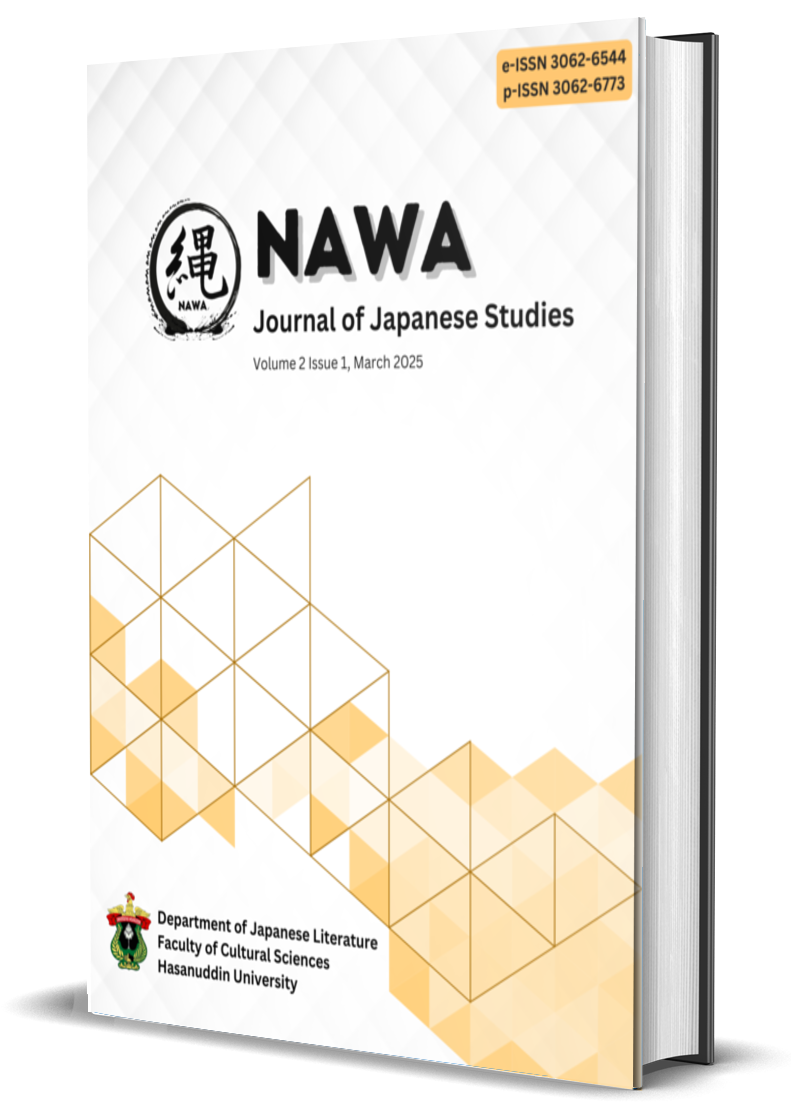Pembentukan dan Makna Gairaigo dalam Anime Yuru Camp Season 1 (2018)
DOI:
https://doi.org/10.69908/nawa.v2i1.43171Keywords:
gairaigo, word formation, anime, morphology, linguisticAbstract
In the era of globalization, the Japanese language has increasingly absorbed foreign vocabulary, particularly English, a phenomenon known as Gairaigo. This can be observed across various fields, including in the dialogues of the anime Yuru Camp Season 1 (2018), which depicts the use of Gairaigo in outdoor activities. This study aims to analyze the formation and meaning of gairaigo in Yuru Camp Season 1 (2018) through a morphosemantic approach based on Nomoto’s (2019) theory of gairaigo formation. Gairaigo refers to vocabulary borrowed from foreign languages, particularly English, into the Japanese language. In this research, the researcher uses a descriptive qualitative method to describe and analyze the formation patterns and semantic shifts of gairaigo in the anime. Data were collected through the observation and note-taking technique from the dialogues of 12 episodes of the anime under analysis. The results show that there are 20 gairaigo data points, encompassing various formation categories such as grammatical adaptation, abbreviation, creation (wasei-gairaigo), and konshugo (a combination of wago or kango with gairaigo). The findings suggest that gairaigo in Yuru Camp is not only used in everyday conversation but also undergoes various shifts in meaning depending on the context and usage within popular culture. This study is expected to provide new insights into the role of gairaigo in audiovisual media and how its adaptation process occurs in modern Japanese language.
References
C-Station. (2018). Yuru Camp Season 1 [Serial Anime]. Crunchyroll.
Elisabeth, C., Artana, I. N. R., & Nie Nie, M. G. (2016). Kesan makna dan perubahan makna gairaigo dalam rubrik fashion majalah Seventeen. E-Jurnal Humanis, Fakultas Sastra dan Budaya Unud, 15(3), 8-14.
Elkhaima, dkk. (2022). Analisis perubahan makna gairaigo dalam website Marisol. Omiyage Jurnal Bahasa dan Pembelajaran Bahasa Jepang, 5(1), 28-38. https://doi.org/10.24036/omg.v5i1.411
Haugen, E. (1950). The analysis of linguistic borrowing. Language, 26, 210–231. https:// https://doi.org/10.2307/410058
Mahsun, M. S. (2013). Metode penelitian bahasa: Tahapan strategi, metode, dan tekniknya. Jakarta: PT Raja Grafindo Persada.
Mulyana, D. (2007). Ilmu komunikasi: Suatu pengantar. Bandung: Remaja Rosdakarya.
Nomoto, K. (2019). Gairaigo no keisei to imi no henka: Nihongo ni okeru eigo no juyou to bunpou teki tokusei [The formation and meaning changes of gairaigo: The acceptance of English in Japanese and its grammatical characteristics]. NINJAL Kokusai Kenkyu Senta Kenkyu Houkoku, 16, 1–26. https://repository.ninjal.ac.jp/record/1856/files/kk_nkss_016.pdf
Pateda, Mansoer.2010.Semantik Leksikal (Edisi Kedua).Jakarta: Rineka Cipta
Rasyid, H., Mansyur, & Suratno. (2009). Asesmen perkembangan anak usia dini. Yogyakarta: Multi Pressindo.
Ramlan, M. (1987). Morfologi Satuan Tinjauan Deskriptif. Yogyakarta: CV. Karyono.
Sudjianto, & Dahidi, A. (2012). Pengantar linguistik bahasa Jepang. Jakarta: Kesaint Blanc.
Shogakukan. (n.d.). Dijitaru Daijisen. Goo Dictionary. https://dictionary.goo.ne.jp
Sukmadinata, N. S. (2017). Metode penelitian pendidikan. Remaja Rosdakarya.
Thomason, S. G. (2001). Language contact: An introduction. Edinburgh: Edinburgh University Press Ltd.
Wilistiyani, dkk. (2018). Analisis perubahan makna gairaigo dalam majalah Garuda Holidays.
Downloads
Published
How to Cite
Issue
Section
License
Copyright (c) 2025 Ayudya Aldi Bisma, Hidayati Yanti, Aulia Arifbillah Anwar

This work is licensed under a Creative Commons Attribution-NonCommercial 4.0 International License.







